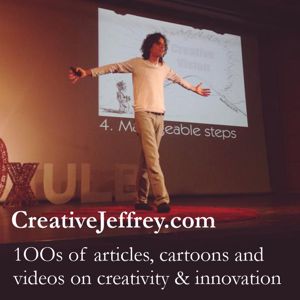Report 103
Your newsletter on applied creativity, imagination, ideas and innovation in business.
Wednesday 20 February2013
Issue 223
Hello and welcome to another issue of Report 103, your twice-monthly (or thereabouts) newsletter on creativity, imagination, ideas and innovation in business.
As always, if you have news about creativity, imagination, ideas, or innovation please feel free to forward it to me for potential inclusion in Report103. Your comments and feedback are also always welcome.
Information on unsubscribing, archives, reprinting articles, etc can be found at the end of this newsletter.
Note
Most articles in this issue of Report 103 can also be found in the archives together with dozens more articles, papers and thoughts.
In this issue of Report 103
- Creative Decision Making
- Implementing Ideas: Baby Steps
- Why Fighting for Our Ideas Makes them Better
Creative Decision Making
By Jeffrey Baumgartner
When we face a decision, we typically see two options: do it or do not do it. Sometimes there is a third, compromise option: partially do it. Even when facing a series of specific choices, it usually seems there are not so many. "Do I replace my old Ferrari with new Ferrari, a Lamborghini or an Aston Martin?" The truth is, however, most decisions have many more options available. It just takes a little creativity to find them. Moreover, those creative but less obvious options are often superior to the obvious ones.
The trick to creative decision making is the same as the first step of anticonventional thinking: consider your goal, turn it around in your mind, question it and deconstruct it. Once you have done that, consider what actions you might take in order to achieve the goal -- or goals. Difficult decisions are often about choosing between two conflicting goals. When you do this, you often discover an option that was not obvious when you initially faced your decision.
The mistake most people make when facing a decision is to focus on the advantages and disadvantages of each obvious option rather than thinking about the goals implicit in the decision.
Let us look at a couple of examples.
Example 1: The Plagiarist
In the relatively early days of the world wide web, I belonged to a now defunct forum for international business people. One member of the forum -- I've forgotten her name, so let's call her "Jane" -- had a lucrative small consultancy. On her web site, she had a lot of free papers, articles and other information that brought prospective clients to the site and demonstrated her expertise. Clients could then buy her consulting services as well as more detailed reports and research.
One day, Jane posted to the forum that she had discovered that some guy in another country had built a web site very similar to hers. He had put all of her articles and papers on his web site, but made it look like they were his articles. She asked the group for advice on how to deal with this guy.
What would you have suggested?
Of course, most people saw only two options: take action or ignore the situation. Those who opted for action mostly suggested contacting the guy and threatening legal action (side note: never, ever threaten legal action unless you really and truly intend to take legal action and then get advice from a lawyer before threatening legal action; anyone who has been in business long enough to have run into legal disputes knows that a letter threatening vague legal action pretty much guarantees the sender will not take any such legal action). The other side argued that legal action is a long and costly process and not worth it. They also felt that threats would not deter the plagiarist. They suggested she simply ignore him.
In short, most people saw that there was a choice of only two roads Jane could take: legal threats (or similar action) or ignore the situation. I saw at least one more road. I suggested that she contact the plagiarist and invite him to become an authorised associate. He could keep the web site, though he'd be expected to make a few changes. He could keep all the papers and reports, provided he made it clear Jane was the author. He could sell Jane's more detailed reports and services and he would get a commission for every sale he made. In effect, it could be a win-win situation. Jane gets more publicity for her services, a potential drain on her business becomes a potential income stream and the plagiarist can operate legitimately and with the support of Jane -- and this will almost certainly result in a longer and more lucrative business for him.
Why was I the only one, out of 20-30 people, who saw this option? Most likely it was because I thought about her problem -- the plagiarist stealing business and credit -- and her goal which was not to get rid of the plagiarist, but to get rid of the resultant drain on her business. Everyone else was focusing on the plusses and minuses of taking action against the plagiarist.
Declining Business
Now, let's consider a hypothetical example of a company, we'll call it "Office 103", that makes and sells high quality office furniture near a big city. The economy has slowed and, as a result, Office 103 is overstocked with office furniture that it is finding very difficult to sell. Competitors, who face the same problem, have all slashed prices and offered special financing deals to clear their stock. You are the CEO. You need to make a decision. Do you slash prices lower than the others? Do you offer even better financing deals? If you do, you might clear the stock, but you will lose money and could tarnish your reputation as a quality furniture provider. You might also get in a price war with your competitors.
Alternatively, you could maintain prices and promote your quality in hopes that the market will pick up and you will maintain your quality reputation. In short, the obvious options are: do you reduce prices or do you maintain prices.
But if you think about the goals: (1) to generate income and (2) clear office furniture from the warehouse, you can readily come up with other options, such as:
-
Double your prices and add some additional services, such as fitting, maintenance, cleaning and perhaps a guarantee to buy back furniture at half price if clients have to dismiss staff. This way, you do not need to sell as much furniture to cover operational costs and pull a profit. And, even if a business sells back furniture, you are not out of pocket!
-
Make deals with office building owners who are looking for tenets. Suggest they offer furnished offices as an option (for a slightly higher rent). You provide the furniture and take a percentage of the rent in exchange.
-
Offer a service-based model, such as renting the furniture for events or leasing the furniture for a monthly payments
How about you? Can you come up with other, creative options? The trick, of course, is not to think about the obvious options, but to think about the goals and then devise creative options that achieve those goals as best as possible.
Indeed, this is something you can apply to all kinds of decision in business and life.
An Easy Decision: Hire Me!
Fortunately, the decision of whether or not to hire me to run a creativity workshop or speak at your next event is an easy one! You and your colleagues will leave the event with a better understanding of how to achieve goals through creative thinking and, especially, anticonventional thinking. That translates into more creativity for your business and that translates into more innovation.
Whether you want a short talk, a musical meditation workshop or a full day or two immersion in the anticonventional thinking process, I am here to help you and your colleagues. Contact me -- or reply to this newsletter -- to talk about your requirements.
Implementing Ideas: Baby Steps
So your creative, collaborative team has come up with the stunning, incredible idea to power all of your factories with wind and solar power. It's an idea that is sexy, green and sure to garner good publicity for your company. At least it seemed an awfully good idea when your team dreamed up the idea over beer at the pub around the corner from the office last night. But now that you are back at your desk, it seems a rather overwhelming change to inflict upon your company. Worse, everyone whom you've shared the idea with thinks you are "out of your mind!" And, indeed, you are beginning to wonder how many beers you and your teammates had last night.
This kind of thing often happens following the birth of a great idea, whether it is over drinks after work, the result of a brainstorm or a suggestion submitted to your idea management software. Big, crazy, breakthrough ideas seem wonderful when you are dreaming them up, but frightening when it comes time to implement them. Fortunately, the field personal development has a technique that you can apply: personal development planning (PDP). Indeed, this approach is so simple and effective, I have included it in as the fourth and final step of the anticonventional thinking process.
Personal Development Planning (PDP)
PDP is about achieving personal goals. Just like creative ideas, personal goals can seem desirable when you dream about them but overwhelming to implement. The 50 year old accountant, who is bored with her job and dreams of travelling around the world on her bicycle, finds it easier to dream about her big goal than to take the steps necessary to achieving it. Why? Because the dream involves a lot of frightening change: giving up her job and reliable income; travelling to strange and possibly dangerous places; funding the trip; and returning to the world of work after a year or more cycling the world.
PDP says you should break the goal down into smaller, achievable steps and envisioning each step. In the case of the accountant, the first steps might include: joining a bicycling club to gain more experience and talk to others with the shared interest; planning relatively short bicycle trips during her holidays, calculating costs and putting aside some money each month; and so on. Small steps such as these are sometimes called "baby steps". Baby steps are less intimidating and eminently more doable than running blindly into your goal. PDP says that when you take such a baby-steps approach you are much, much more likely to achieve it than if you just dream it.
PDP also says you should focus your thinking on each step, what needs to be done in order to achieve it and how you will feel about. This will make it easy to tackle each step towards your goal. Importantly, with each completed step, you will achieve some of the satisfaction of accomplishing a goal.
Applying It to Innovation
In business, a creative idea is essentially an original way of achieving a goal. In our example, you and your team came up with a great way to substantially reduce your business's carbon footprint and reliance on fossil fuels. However, implementing it in one fell swoop would be a massive undertaking. No wonder it seems scary when you get to your desk. No wonder your boss won't approve it. The end point of the implemented idea -- or goal -- may be desirable, but the necessary change is intimidating! But, just like our 50 year old accountant who dreams of cycling round the world, you can break your big idea into baby steps. These will make the idea more doable, easier to sell to your boss and much more likely to happen.
In our example, your first steps might include: identifying factories suitable for a pilot test; getting sunshine and wind information for each of those locations; selecting a factory to serve for the pilot test; installing a small wind turbine; installing solar panels; compiling results; extrapolating requirements for a powering an entire factory with renewable energy; and so on. Each of these steps is relatively small, will cost little and poses minimal risk to you or your company. If you see failure early on, you can re-evaluate the project and make changes or even cancel it before any substantial investment or change has taken place.
Responsibility
However, there is one more thing you need to do. In personal development, the person who is developing herself needs to take charge off each step in her path to achieving her goal. In team led innovation in an organisation, you need to ensure that there is a person responsible for each and every baby step. And, in the very first steps, the people in charge need to be members of your team. If you do not do this, you can be sure even the baby steps will never be taken! (In a recent anticonventional thinking workshop in which participants were breaking their ideas into baby steps, I saw a small team enthusiastically preparing a list off steps. Indeed, I thought they were a little too enthusiastic. When I spoke with them, I found that they were happily assigning steps to their colleagues and none to themselves! I pointed out that while this would make the tasks easier from their perspective, it substantially reduced the likelihood of their idea being implemented. At minimum, their first steps would have to be to convince their selected colleagues to take charge of their assigned steps. I am sorry to say that the team's enthusiasm was reduced substantially by this insight --but their planning improved dramatically!)
This approach is remarkably effective1, whether you want to implement changeS across your company or within a team or division. Moreover, it empowers the owners of an idea to take steps towards implementing it. For this reason, it has been included as the fourth step of the anticonventional thinking (ACT) process. But it can also be used with ideas selected from idea management tools, brainstorming and elsewhere.
Reference
1) Fernando Cardoso de Sousa (2102) "What if you change IWWMI into WASNT?"; Report 103 - jpb.com
Why Fighting For Our Ideas Makes Them Better
David Burkus has written an interesting article on why criticism and debate during idea generation and development are healthy and creative. He also writes about how to ensure the debate is productive. You can read his article at http://99u.com/articles/7224/Why-Fighting-For-Our-Ideas-Makes-Them-Better.
Interact with Me!
I am on the social networks and would love to connect with you there.
Facebook
Join me on my professional
page on Facebook –
LinkedIn
You can also connect
with me on LinkedIn.
Twitter
And you can follow me on Twitter.
I’m @creativejeffrey
ARCHIVES
You can find this and every issue of Report 103 ever written at our archives.
Happy thinking!
Report 103 is a complimentary eJournal from Bwiti bvba of Belgium (a jpb.com company: http://www.creativejeffrey.com). Archives and subscription information can be found at http://www.creativejeffrey.com/report103/
Report 103 is edited by Jeffrey Baumgartner and is published on a monthly basis.
You may forward this copy of Report 103 to anyone, provided you forward it in its entirety and do not edit it in any way. If you wish to reprint only a part of Report 103, please contact Jeffrey Baumgartner.
Contributions and press releases are welcome. Please contact Jeffrey in the first instance.




